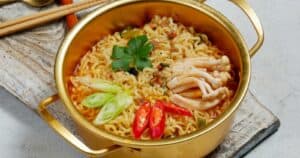Ramen noodles are delicious, but the secret ingredient taking them to a whole new level is that magical seasoning packet. Have you ever wondered what exactly is in the ramen seasoning that makes the noodles so crazily savory and addictive?
The answer is that ramen seasoning contains a special blend of ingredients carefully calibrated to add the perfect punch of flavor. By using dried vegetables, meat powders, salty seasonings, and even MSG, the packets provide everything needed to transform plain noodles into an insanely delicious soup.
In this article, we’ll explore the origins of ramen seasoning, break down the key ingredients typically found inside those seasoning packets, and even look at creative ways to use them beyond just noodles. Read on to become an expert in all things ramen seasoning so you can create customized bowls of maximum flavor!
A Brief History of Ramen Seasoning
To understand modern ramen seasoning, let’s start with a quick history lesson. Ramen originated in China as a version of a noodle soup called lamian. Chinese immigrants then introduced ramen to Japan in the late 19th century.
The seasonings evolved over time, but Japanese cooks ultimately created the ramen seasoning blend recognizable today. They specifically designed the flavored packets to accompany instant ramen invented in 1958.
These convenient seasoning packets allowed busy cooks to quickly transform basic noodles into a meal bursting with flavor. Over decades, companies have finely tuned the
Core Ingredients Found in Ramen Packets
Ramen seasoning packets contain a mix of dried, concentrated ingredients calibrated to add maximum flavor. Here are some of the essential elements commonly found:
- Salt – The primary flavor that seasons the broth.
- Monosodium glutamate (MSG) – Enhances savory umami flavor.
- Dried onion and garlic – Provides a savory, aromatic base.
- Sugar – Balances out saltiness and supports caramelization.
- Dried celery and carrot slivers – Adds subtle vegetal sweetness.
- Sesame oil powder – Rich, nutty flavor and aroma.
- Soy sauce powder – Adds a salty, fermented taste.
- Chicken or beef powder – Meaty, savory flavor.
- Dried mushrooms – Deep, earthy umami notes.
- Chili powder – A touch of heat and smokiness.
These ingredients combine to provide the beautifully balanced seasoning that makes ramen broths so crave-worthy. But different brands use their own proprietary blends with additional spices, vegetables, and flavor enhancers.
Ramen Seasoning Provides Powerful Umami Flavor
One of the central goals of ramen seasoning is to provide powerful umami flavor – that sought-after savory taste that makes you crave more. Two key ingredients bring the umami:
Monosodium glutamate (MSG): This controversial additive boosts savory glutamate, which binds to umami receptors on the tongue.
Dried shiitake mushrooms: Packed with natural glutamate and guanylate, dried mushrooms offer umami without MSG.
When skillfully blended, these umami-rich ingredients create a broth that tastes satisfyingly meaty and moreish. The seasoning tricks your brain and tastebuds into thinking you’re eating a hearty, protein-rich meal.
Creative Uses for Ramen Seasoning Packets
Don’t limit ramen packets just to noodles! Their intense flavors can enhance a variety of dishes:
- Coat air-fried veggies or chicken with a seasoning blend.
- Mix into ground meat for savory burgers or meatloaf.
- Toss with popcorn for a movie snack with a kick.
- Sprinkle on deviled eggs for a flavor packed snack.
- Use to season a veggie or potato hash.
- Whisk into gravies or pan sauces for extra flavor.
- Make a unique salad dressing with oil and vinegar.
- Create a soup stock by simmering in water.
With some creativity, ramen seasoning can become your secret flavor weapon in the kitchen!
Variations on Classic Ramen Seasoning
While traditional ramen packets contain familiar ingredients like dried veggies and MSG, some modern ramen brands offer inventive seasoning twists:
Spicy varieties blend in chili, garlic, and onion for extra heat. They range from mildly spicy to blow-your-socks-off hot.
Miso ramen seasoning incorporates white or red miso paste for a nutty, fermented flavor.
Tom yum ramen contains Thai herbs and lime for tangy citrus notes.
Tonkotsu ramen uses an intense pork bone broth as the base for richer flavor.
Vegan seasonings omit the meat powders and fish products, instead using mushrooms, seaweed, and soy.
DIY seasoning bags allow you to customize your own perfect
Ramen fans can find a seasoning variety to suit any palate – from mild to wildly adventurous.
Demystifying the Role of MSG
Any discussion of ramen seasoning can’t ignore the elephant in the room – MSG. This controversial ingredient plays an integral role but also scares some people away.
MSG (monosodium glutamate) enhances savory umami flavor. When combined with salt, it stimulates taste receptors to perceive more full, complex flavor.
Some individuals do experience adverse effects from MSG like headaches or flushing. However, decades of research have failed to demonstrate serious health risks for most people consuming moderate amounts.
Still, the negative perceptions around MSG lead some brands to eliminate it from their seasoning. Consumers can choose varieties with or without it based on personal preference.
Ramen Packets Pack a Salty Punch
One downside of ramen seasoning is its high sodium content. A single packet can contain up to 2,000 mg of sodium – the total daily recommended limit.
Consuming high sodium levels long-term negatively impacts blood pressure and heart health. Those with medical conditions like hypertension should take care when eating packaged ramen.
When cooking, you can control sodium intake by using just a portion of the seasoning packet and adding extra vegetables, lean protein, herbs, and spices.
Making broth from scratch instead of using the packet also allows you to manage sodium levels. With a few adjustments, you can still enjoy ramen’s bold flavors without going overboard on salt.
Harnessing the Magic of Ramen Seasoning Packets
Ramen seasoning packets provide an easy shortcut to create a bowl of noodles bursting with addictive flavor. Now that you know what’s inside those little bags of magic, you can whip up your own seasoned ramen or incorporate the spices into other dishes.
Understanding the origins, key ingredients, sodium content, and variations of ramen seasoning gives you total mastery over customized ramen deliciousness. So grab some noodles and your favorite packet and start seasoning up some next-level homemade ramen soup!





